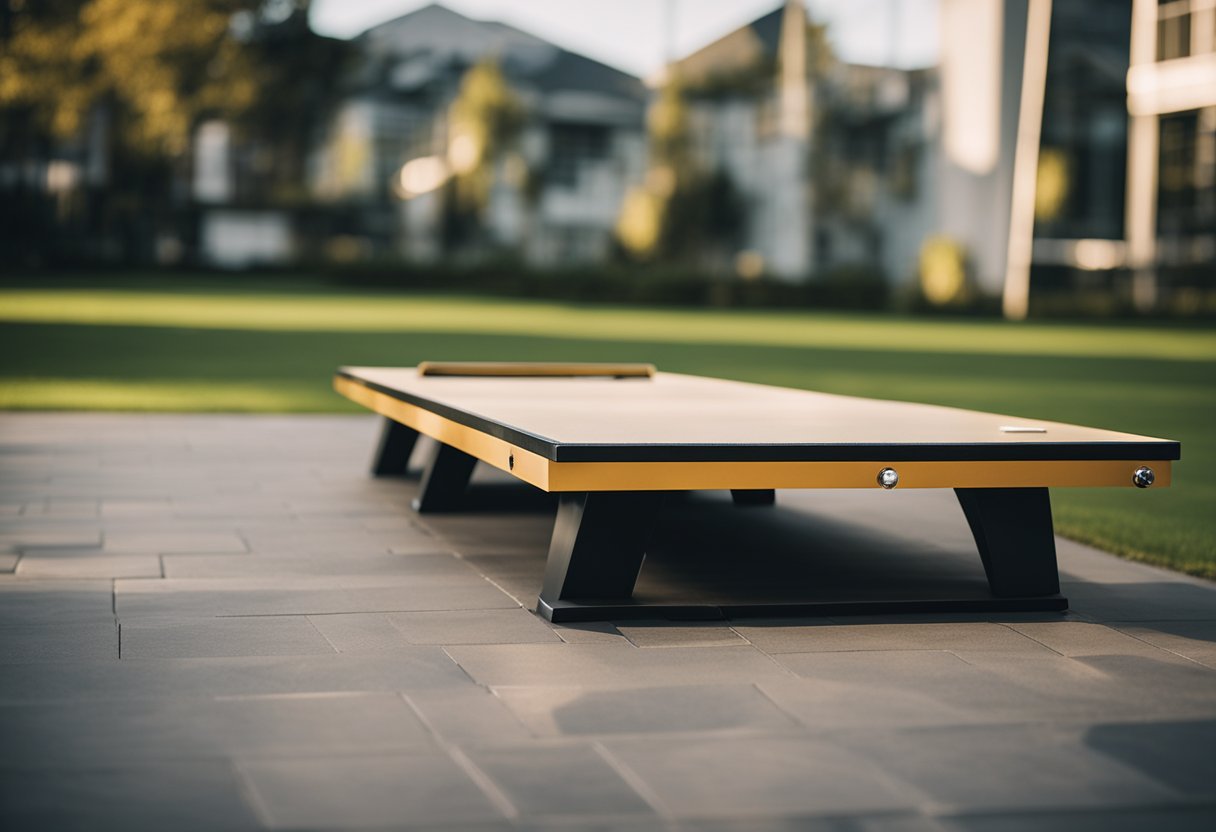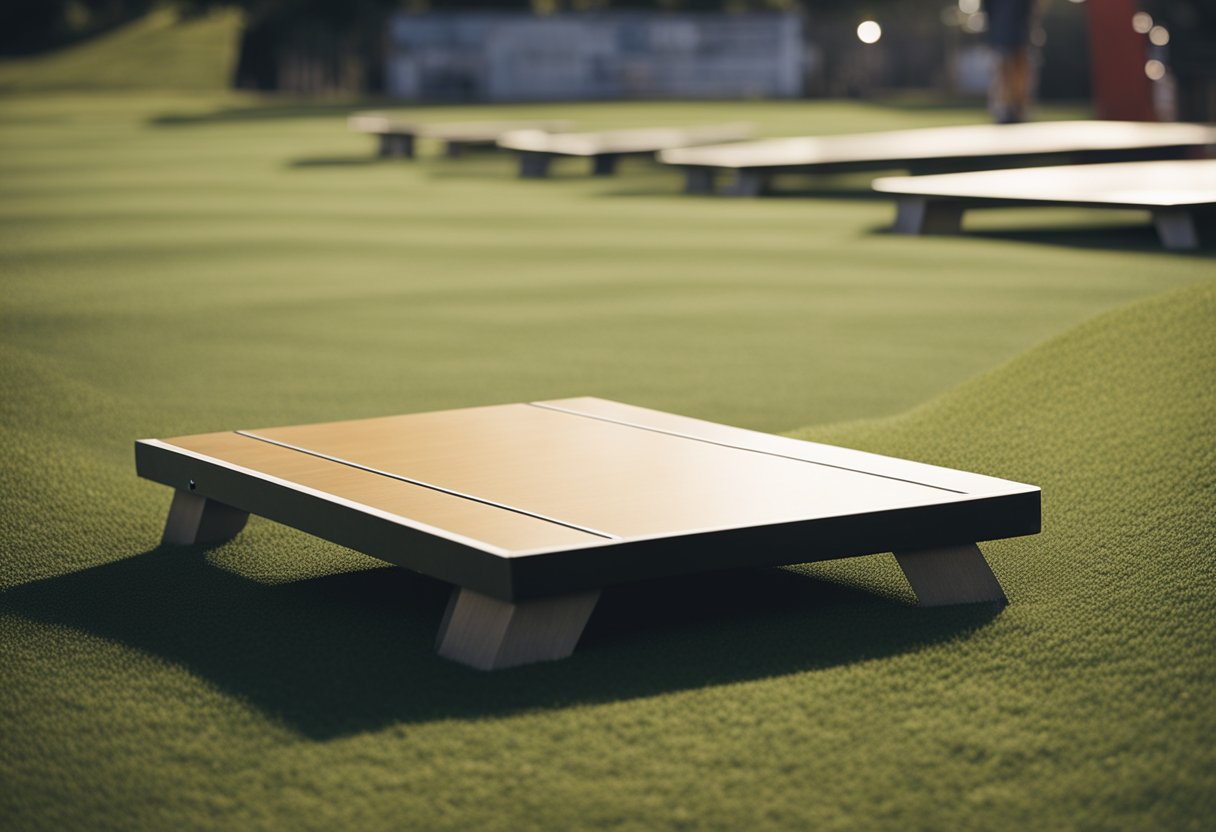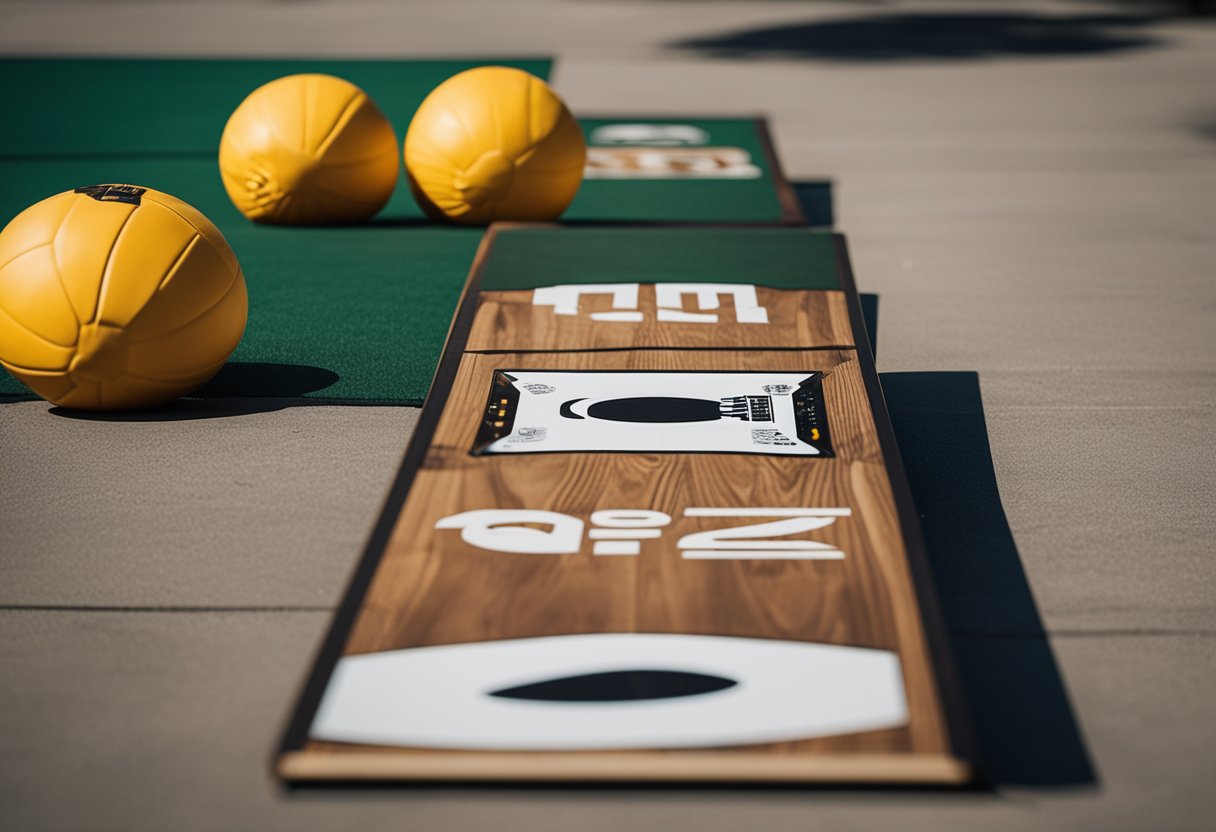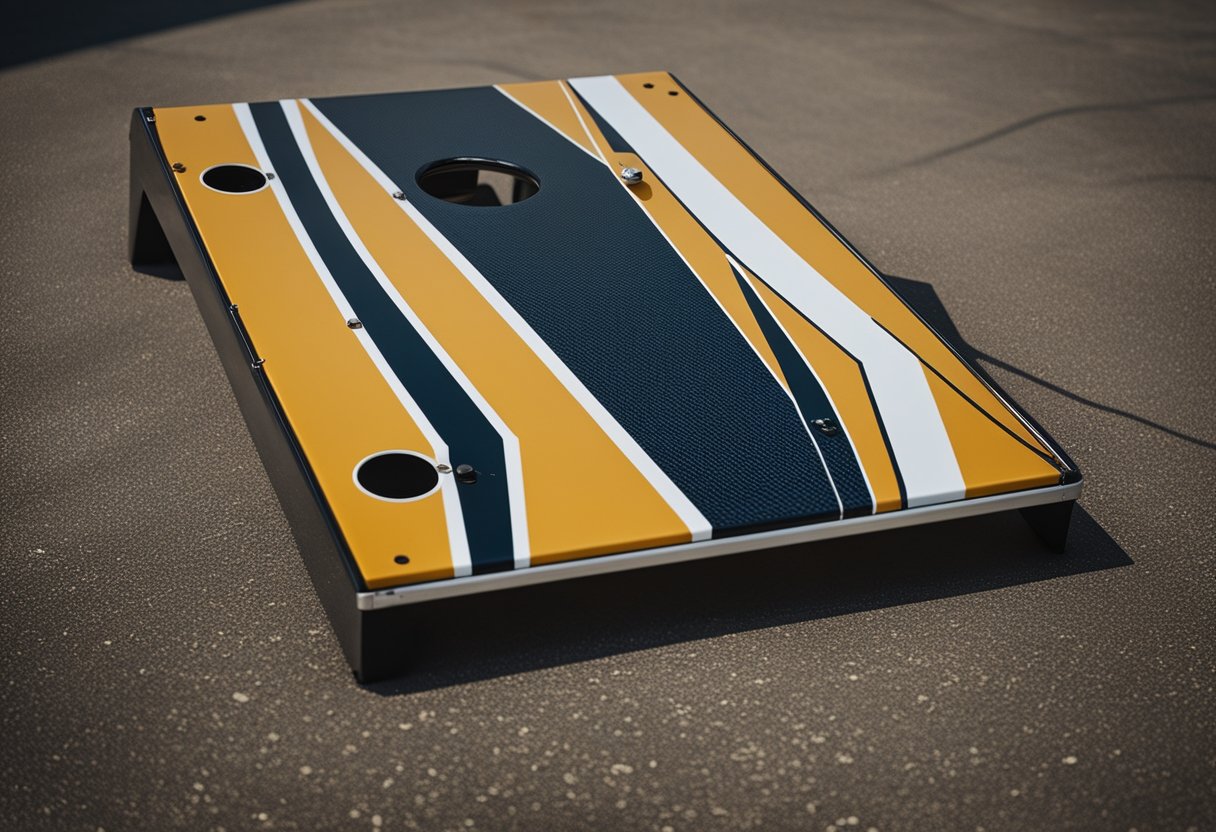I have been playing cornhole for years, and I know how frustrating it can be when your board is too slick. It can make the game less fun and even affect your performance. Fortunately, there are several ways to address this issue and get your board to the optimal level of slickness.
Understanding cornhole boards is crucial to addressing the slickness problem. The surface of the board should be smooth and consistent, with no bumps or warping. The material can be made of wood, plastic, or other materials, but it should be sturdy and durable. The bags should slide smoothly across the surface, but not too fast or too slow.
Factors influencing slickness can include the age of the board, the material it is made of, and the type of bags being used. Preventing overly slick boards can be done by using the right bags, avoiding certain materials, and avoiding excessive polishing or waxing. The sanding process can also be used to adjust the slickness of the board, but it should be done carefully and with the right tools.
Key Takeaways
- Understanding the factors influencing slickness is crucial to addressing the issue.
- The sanding process can be used to adjust the slickness of the board.
- Preventing overly slick boards can be done by using the right bags and avoiding excessive polishing or waxing.
Understanding Cornhole Boards
https://www.youtube.com/watch?v=fW-cKxvCnLY&embed=true
As a cornhole player, I understand the importance of having the right equipment to play the game. One of the most critical pieces of equipment is the cornhole board. A cornhole board is a rectangular wooden board with a hole in the center. The board is typically made of wood, although some boards are made of plastic or metal.
When it comes to cornhole boards, quality matters. A well-made board will have a smooth surface that allows the cornhole bags to slide easily. The arc of the board is also important. A good cornhole board should have a slight arc to it, which helps the bags slide into the hole.
One problem that players can encounter is a board that is too slick. A board that is too slick can cause the bags to slide off the board, making it difficult to score points. There are several reasons why a board might be too slick, including the type of wood used, the finish on the board, and how well the board has been maintained.
To prevent a board from becoming too slick, it is important to choose the right type of wood. Hardwoods like oak and maple are popular choices for cornhole boards because they are durable and have a tight grain that resists wear and tear.
Another factor to consider is the finish on the board. A good finish will protect the wood from moisture and other elements that can cause it to warp or crack. However, if the finish is too slick, it can make the board difficult to play on.
In conclusion, understanding the basics of cornhole boards is essential for any player. Knowing what to look for in terms of quality, arc, and finish can help you choose the right board for your needs. By taking care of your board and making sure it is not too slick, you can enjoy hours of fun playing cornhole with your friends and family.
Factors Influencing Slickness
https://www.youtube.com/watch?v=aGA0c61onYo&embed=true
As I have researched, there are several factors that can influence the slickness of cornhole boards. In this section, I will discuss some of the most important ones.
Materials and Finish
The materials used to construct cornhole boards can have a significant impact on their slickness. For example, boards made of plastic are generally slicker than those made of wood. Similarly, boards with a glossy finish tend to be slicker than those with a matte finish.
One way to reduce the slickness of a board is to add a layer of paint or finish. However, it is important to choose the right type of paint or finish. A clear coat, for example, can make a board more slippery, while a textured paint can provide more grip.
Humidity and Weather Conditions
Humidity and weather conditions can also play a role in the slickness of cornhole boards. In general, wet conditions can make boards more slippery, while dry conditions can make them more sticky.
If you are playing in humid conditions, it may be helpful to use a board with a rougher texture or to add some grip-enhancing material to the board. Conversely, if you are playing in dry conditions, you may want to use a board with a smoother finish or to add a layer of clear coat to the board.
By considering these factors, you can make informed decisions about the materials and finishes you use for your cornhole boards, and adjust your playing conditions to optimize your game.
Preventing Overly Slick Boards
https://www.youtube.com/watch?v=xqeB6dEVprE&embed=true
As a cornhole player, I know how frustrating it can be to play on overly slick boards. The bags don’t stick to the surface, and it can make the game less enjoyable. However, there are several steps you can take to prevent your cornhole boards from becoming too slick.
Choosing the Right Paint
When painting your cornhole boards, it’s important to choose the right type of paint. Some paints are slicker than others, and this can affect the surface of the board. One option is to use a primer before painting, as this can help the paint adhere better to the surface. Additionally, using a water-based polyurethane or oil-based polyurethane can help to seal the paint and provide a non-slip surface.
Applying Non-Slip Coating
Another option is to apply a non-slip coating to the surface of your cornhole boards. This can be done using a spray-on or brush-on coating that is specifically designed for use on wood surfaces. These coatings are typically clear and will not affect the color or appearance of the board. It’s important to follow the manufacturer’s instructions when applying the coating, as improper application can lead to a less effective non-slip surface.
Using the Right Sealant
Finally, using the right sealant can also help to prevent your cornhole boards from becoming too slick. A varnish or clear urethane sealant can be applied to the surface of the board to provide a protective layer that also helps to prevent the bags from sliding. It’s important to choose a sealant that is appropriate for use on wood surfaces and to follow the manufacturer’s instructions for application.
By following these steps, you can prevent your cornhole boards from becoming too slick and ensure that you can enjoy your game to the fullest.
The Sanding Process
https://www.youtube.com/watch?v=R7e3iWmnT6o&embed=true
When it comes to making cornhole boards less slick, sanding is a crucial step. Sanding the surface of the boards will create a rougher texture, which will help bean bags grip better and prevent them from sliding off. In this section, I will discuss the two main aspects of the sanding process: choosing the right sandpaper and proper sanding techniques.
Choosing the Right Sandpaper
Choosing the right sandpaper is essential to achieve the desired results. The grit of the sandpaper determines how rough the surface of the board will become. Typically, medium-grit sandpaper with a grit size of 80-120 is ideal for sanding cornhole boards. This grit size is rough enough to create a textured surface, but not so rough that it damages the wood.
Proper Sanding Techniques
Proper sanding techniques are also important to ensure that the sanding process is effective and efficient. Here are the steps to follow when sanding cornhole boards:
-
Begin by cleaning the surface of the board to remove any dirt, dust, or debris that may be present. This will ensure that the sandpaper can make contact with the wood and remove any imperfections.
-
Next, use a medium-grit sandpaper to sand the surface of the board in the direction of the wood grain. Sanding against the grain can cause the wood to splinter and damage the board.
-
Be sure to apply even pressure to the sandpaper as you sand. Uneven pressure can cause the board to become uneven and result in an inconsistent playing surface.
-
After sanding the entire surface of the board with the medium-grit sandpaper, switch to a finer-grit sandpaper with a grit size of 220-320. Sand the surface of the board again in the direction of the wood grain, using even pressure.
-
Finally, use a dry cloth to wipe away any dust or debris that may be present on the surface of the board.
By following these steps, you can effectively sand your cornhole boards to create a rougher surface that will prevent bean bags from sliding off.
Maintenance for Optimal Slickness
https://www.youtube.com/watch?v=aXWE7hTZnrw&embed=true
As a cornhole enthusiast, I understand the importance of maintaining the optimal slickness of the cornhole board. A slick board can make the game challenging and enjoyable, but a board that is too slick can be frustrating and ruin the game. Therefore, it is crucial to keep the board’s slickness at an optimal level. In this section, I will discuss the maintenance steps that you can take to ensure your board remains slick.
Cleaning Your Boards
Cleaning your cornhole board is essential to maintain optimal slickness. Dirt, grime, and other debris can accumulate on the board, causing it to lose its slickness. Therefore, it is essential to clean the board regularly. You can use a damp cloth to clean the surface of the board, removing any dirt or grime that may be causing the slipperiness. If the board is particularly dirty, you can use a mild detergent to clean it.
When to Repaint
Repainting your cornhole board is another way to maintain optimal slickness. If the board is painted, the paint can wear off over time, causing the surface to become less slick. Therefore, it is important to repaint the board regularly to maintain its slickness. However, it is crucial to use durable paint that can withstand the elements and the wear and tear that comes with playing the game.
In conclusion, maintaining optimal slickness is crucial to enjoying the game of cornhole. Cleaning your board regularly and repainting it when necessary can help you achieve this. By following these steps, you can ensure that your cornhole board remains slick and enjoyable to play on.
Assessing Board Slickness
As a cornhole player, I know how important it is to have the right level of slickness on the boards. Too slick, and the bags will slide right off; not slick enough, and they won’t slide at all. So, how do you assess board slickness?
One way to determine slickness is to perform a slide test. Take a bag and slide it across the board from one edge to the other. If the bag slides too quickly, the board is too slick. If it doesn’t slide at all, the board is not slick enough. A good rule of thumb is that the bag should slide about 12 inches before coming to a stop.
Another way to assess board slickness is to play on the boards and see how they feel. Experienced players may be able to tell right away if the boards are too slick or not slick enough. If you’re new to the game, it may take some time to get a feel for what’s right.
I found a discussion on r/cornhole where users shared their tips on adjusting board slickness. Some suggested playing on the boards to wear off the slickness, while others recommended using Windex to reduce the slickness. However, it’s important to note that using any cleaning solution may damage the board’s surface and affect its performance.
In tournaments, board slickness is often regulated to ensure a fair playing field. According to Sweetwater Cornhole, a new 100% duck cloth corn bag should slide between 16-46 inches on a brand new board, while a gently used bag should slide between 18-48 inches on a broken-in board. It’s important to check the regulations of the tournament you’re participating in to ensure your boards meet the requirements.
Overall, assessing board slickness is an important part of the game. By performing a slide test, playing on the boards, and checking tournament regulations, you can ensure that your boards are at the right level of slickness for a fun and fair game of cornhole.
Professional Recommendations
As a professional cornhole player, I have come across many cornhole boards that are too slick for optimal gameplay. After trying various methods to improve the board’s functionality and effectiveness, I have found some recommendations that work well.
First and foremost, it is essential to personalize your cornhole board. This can be done by adding a logo or design of your choice. Not only does this add to the overall aesthetic appeal of the board, but it also makes it easier to identify your board at events.
Secondly, I recommend using ACL boards as they are the standard for professional cornhole play. These boards have specific dimensions and specifications that make them ideal for tournament play.
To improve the slickness of the board, I recommend using an anti-slip paint specifically designed to create a slip-resistant surface on your cornhole boards. This will provide a textured grip and prevent slipping, making it easier to throw bean bags accurately.
Another option is to apply a rubberized coating to the surface of the boards. This will also provide a textured grip and prevent slipping, making it easier to throw bean bags accurately.
Lastly, it is essential to keep the board clean and free of any debris. This will ensure that the board maintains its effectiveness and functionality.
In conclusion, by personalizing your cornhole board, using ACL boards, and applying anti-slip paint or a rubberized coating, you can improve the slickness of the board and make it easier to throw bean bags accurately. By following these professional recommendations, you can ensure that your cornhole board is tournament-ready and optimized for optimal gameplay.
Frequently Asked Questions
What are the ideal dimensions for a regulation cornhole board?
The ideal dimensions for a regulation cornhole board are 2 feet wide and 4 feet long. The front of the board should be 12 inches from the ground, while the back should be 15 inches from the ground. The hole should be 6 inches in diameter and centered 9 inches from the top of the board and 12 inches from each side edge.
What are some tips for making a cornhole board less slick?
If your cornhole board is too slick, there are a few things you can do to make it less slippery. One option is to play on the board more often, as the slickness will wear off over time. Another option is to use a degreaser, like Simple Green, to remove any excess oils or slickness from the board. Sanding the board with a fine-grit sandpaper can also help to create a rougher surface for better traction.
What is the proper distance between cornhole boards?
The proper distance between cornhole boards is 27 feet from front edge to front edge. This distance should be measured from the center of each board. If you’re playing with children or beginners, you can reduce the distance to 21 feet.
What are the rules for scoring in cornhole?
In cornhole, a bag that goes through the hole is worth 3 points, while a bag that lands on the board and stays on the board is worth 1 point. The game is played to 21 points, and the first player or team to reach 21 points wins. If both players or teams reach 21 points in the same round, the game goes into overtime until one player or team has a higher score at the end of a round.
How do I choose the right cornhole bags?
When choosing cornhole bags, it’s important to consider the weight, size, and material. Regulation bags should weigh between 14-16 ounces and be made of duck cloth or a similar durable material. The bags should be 6 inches by 6 inches and filled with approximately 1 pound of corn feed.
What are the best materials for making cornhole boards?
The best materials for making cornhole boards are solid wood, plywood, or plastic. Solid wood boards are the most durable and provide the best playing surface, while plywood boards are lighter and easier to transport. Plastic boards are the most weather-resistant and can be used in any conditions.

Hi, I’m Sal Muller of Tooltrip.com. My DIY experience led me to understand essential power tools for home projects. Tooltrip.com guides enthusiasts and professionals in choosing right tools for any job. I provide concise top tool reviews for easier, efficient DIY.





